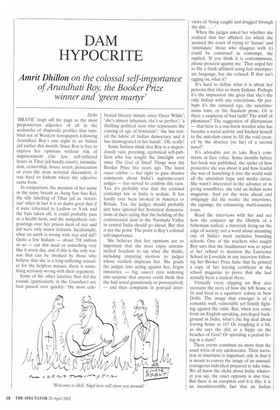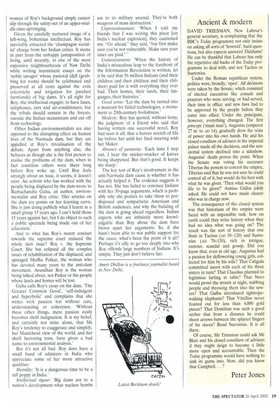DAM HYPOCRITE
Amrit Dhillon on the colossal self-importance
of Arundhati Roy, the Booker Prize winner and 'green martyr'
Delhi 'BRAVE' leapt off the page as the most preposterous adjective of all in the avalanche of rhapsodic profiles that tumbled out of Western newspapers following Arundhati Roy's one night in an Indian jail earlier this month. Since Roy is free to express her opinions without risk of imprisonment (the few, self-inflicted hours in Tihar jail hardly count), intimidation, censorship, house arrest, persecution or even the most notional discomfort, it was hard to fathom where the adjective came from.
In comparison, the mention of her name in the same breath as Aung San Suu Kyi, the silly labelling of Tihar jail as 'notorious' when in fact it is so damn good that if it were relocated to Ludlow or York and the bars taken off, it could probably pass as a health farm, and the sympathetic outpourings over her prison meal of rice and dal were only minor irritants. Incidentally, what on earth is wrong with rice and dal? Quite a few Indians — about 758 million or so — eat this meal or something very like it every day, and if this is the only reason that can be invoked by those who believe that she is a long-suffering crusader for the helpless masses, there is something seriously wrong with their argument.
Some of the other fatuities that did the rounds (particularly in the Guardian) are best passed over quickly: 'the most cele
brated literary inmate since Oscar Wilde'; 'she's almost inhuman, she's so perfect'; 'a thrilling political icon who represents the coming of age of feminism'; 'she has tested the fabric of Indian democracy and it has disintegrated in her hands'. Oh, really!
Some Indians think that Roy is a stupendously vain, preening, egotistical self-publicist who has sought the limelight ever since The God of Small Things won the Booker Prize five years ago. The latest cause celebre — her right to pass abusive comments about India's supreme-court judges — has served to confirm this view. Yes, it's probably true that the criminal contempt law in India is archaic. It has hardly ever been invoked in America or Britain. Yes, the judges should probably just have ignored her hysterical denunciations of their ruling that the building of the controversial dam in the Narmada Valley in central India should go ahead. But that is not the point. The point is Roy's colossal self-importance.
She believes that her opinions are so important that she must enjoy untrammelled freedom to say what she thinks, including imputing motives to judges whose verdicts displease her. She goads the judges into acting against her, feigns innocence — big, saucer eyes widening into surprise that anyone could think that she had acted gratuitously or provocatively — and then complains in post-jail inter
views of 'being caught and dragged through the shit...
When the judges asked her whether she realised that her affidavit (in which she accused the court of trying to 'harass' and 'intimidate' those who disagree with it) could be construed as contempt, she replied, 'If you think it is contemptuous, please proceed against me.' They urged her to file a fresh affidavit using less intemperate language, but she refused. If that isn't egging on, what is?
It's hard to define what it is about her persona that riles so many Indians. Perhaps it's the impression she gives that she's the only Indian with any convictions. Or perhaps it's the outsized ego, the sanctimonious tone, or the flatulent prose. Or is there a suspicion of bad faith? The whiff of phoniness? The suggestion of dilettantism — that here is a one-book novelist who has become a social activist and hitched herself to the anti-dam cause to fill the void created by the absence (so far) of a second novel?
It's advisable not to take Roy's comments at face value. Some months before her book was published, she spoke of how protective she was about it and how fearful she was of launching it into the world with all the attendant hype and media circus. She wasn't interested in the advance or in giving soundbites, she told an Indian news magazine. And yet she went ahead and obligingly did the works: the interviews, the signings, the exhausting, multi-country tours.
Read the interviews with her and see how she conjures up the lifestyle of a bohemian radical, a maverick living on the edge of society; not a word about attending one of India's most exclusive boarding schools. One of the teachers who taught Roy says that the headmaster was so upset at her refusal to mention the Lawrence School in Lovedale in any interview following her Booker Prize fame that he printed a copy of her leaving certificate in the school magazine to prove that she had actually been a student there.
Virtually every clipping on Roy also recounts the story of how she left home at 16 and lived in a squatters' colony in New Delhi. The image that emerges is of a romantic waif, vulnerable yet feistily fighting against the odds, But, when you Come from an English-speaking, privileged background in India, what's the big deal about leaving home at 16? Or roughing it a bit, as she says she did, as a hippy on the beaches of Goa? Or spending a period living in a slum?
These events constitute no more than the usual trivia of any adolescence. Their narration in interviews is important only in that it is meant to convey the image of an unusual, courageous individual prepared to take risks. We all know the cliché about India: whatever you say, the exact opposite is also true. But there is an exception and it is this: it is an incontrovertible fact that an Indian woman of Roy's background simply cannot slip through the safety-net of an upper-middle-class upbringing.
Given the carefully nurtured image of a left-wing, bohemian intellectual. Roy has inevitably attracted the 'champagne socialist' charge from her Indian critics. It stems in part from the unhappy juxtaposition of living, until recently, in one of the most expensive neighbourhoods of New Delhi while writing incontinent essays on the 'noble savages' whose pastoral idyll (grubbing for roots) should be celebrated and preserved at all costs against the evils (electricity and irrigation for parched farmlands) of big dams. It's all right for Roy, the intellectual engagee, to have faxes, telephones, cars and air-conditioners, but the tribals should remain in the forests, outside the Indian mainstream and cut off from technology.
Other Indian environmentalists are also opposed to the disrupting effect on human lives of the Narmada dam, but they are appalled at Roy's trivialisation of the debate. Apart from anything else, she behaves as though she is the first person to realise the problems of the dam, when in fact countless others were there long before Roy woke up. Until Roy feels strongly about an issue, it seems, it doesn't exist. An activist who has worked with the people being displaced by the dam wrote to Ramachandra Guha, an author, environmentalist and Roy critic: `Her articles on the dam are points on her learning curve. She is just doing publicly what I learnt in a small group 15 years ago. I can't hold those 15 years against her, but I do object to such a public spectacle being made out of her education.'
And to what has Roy's recent conduct towards the supreme court reduced the whole dam issue? Roy v. the Supreme Court. She has eclipsed all the complex issues of rehabilitation of the displaced; and upstaged Medha Patkar, the woman who has devoted many years to the anti-dam movement. Arundhati Roy is the woman being talked about, not Patkar or the people whose lands and homes will be lost.
Guha calls Roy's essay on the dam, 'The Greater Common Good', 'self-indulgent and hyperbolic' and complains that she writes with passion but without care, understanding or coherence. 'Without these other things, mere passion easily becomes shrill indignation. It is my belief, and certainly not mine alone, that Ms Roy's tendency to exaggerate and simplify, her Manichean view of the world, and her shrill hectoring tone, have given a bad name to environmental analysis.'
But it's not all bad. Roy does have a small band of admirers in India who appreciate some of her more attractive qualities: Humility: 'It is a dangerous time to be a tall poppy in India.'
Intellectual rigour: 'Big dams are to a nation's development what nuclear bombs are to its military arsenal. They're both weapons of mass destruction.'
Unpretentiousness: 'When I told my friends that I was writing this piece [on India's nuclear explosion], they cautioned me. "Go ahead," they said, "but first make sure you're not vulnerable. Make sure your taxes are paid." ' Understatement: 'When the history of India's miraculous leap to the forefront of the Information Revolution is written, let it be said that 56 million Indians (and their children and their children and their children) paid for it with everything they ever had. Their homes, their lands, their languages, their histories.'
Good sense: 'Let the dam be turned into a museum for failed technologies, a monument to 20th-century foolishness.'
Modesty: Roy has quoted, without irony, the judgment of a friend who said that having written one successful novel, Roy had seen it all; that a barren stretch of life lay before her until her final meeting with her Maker.
Absence of paranoia: 'Each time I step out, I hear the snicker-snacker of knives being sharpened. But that's good. It keeps me sharp.'
The key test of Roy's involvement in the anti-Narmada dam cause is whether it has actually helped it. The evidence suggests it has not. She has failed to convince Indians with her 30-page arguments, which is probably why she prefers to take them to predisposed and sympathetic American and British audiences, and why the building of the dam is going ahead regardless. Indian experts who are infinitely more knowledgable than Roy about the dam have blown apart her arguments. So, if she hasn't been able to win public support for the cause, what's been the point of it all? Perhaps it's silly to go too deeply into why Roy offends large numbers of Indians. It's simple. They just don't believe her.
Amrit Dhillon is a freelance journalist based in New Delhi.







































































 Previous page
Previous page